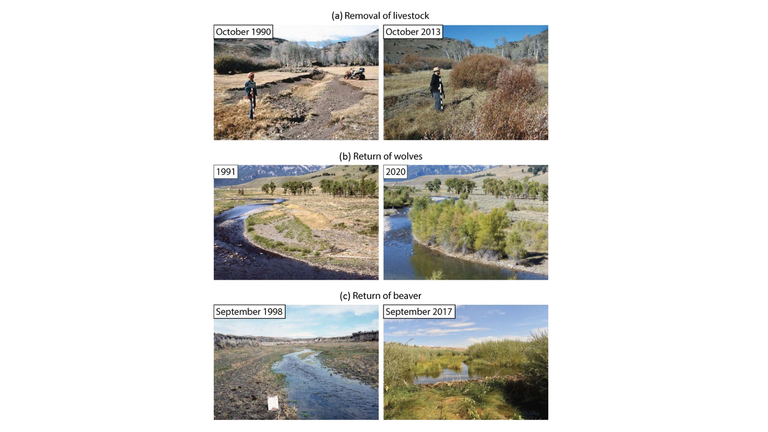Scientists propose rewilding the American West by reintroducing grey wolves and beavers | Science & Tech News

In the face of the growing threats posed to ecosystems by climate change, scientists in the US have put forward an “ultra ambitious” proposal to rewild parts of the American West by reintroducing wolves and beavers.
Their plan follows President Joe Biden signing an executive order for his America the Beautiful policy that involves a conservation effort to save 30% of water and land in the US by 2030.
The administration’s plan is to address “a catastrophic extinction crisis that threatens the biodiversity of our planet and the health of the natural systems that supply our food, water, and other resources”.
It comes as NASA satellite images have revealed the impact on the largest reservoir of water in the US, Lake Mead, of the most severe drought in decades.
In a journal article published in BioScience, titled Rewilding the American West, 20 scientists propose rewilding large reserve areas owned by the US federal government to address these concerns.
They have two major calls. Firstly, to stop livestock grazing on some federal lands, and secondly to restore two key species: the grey wolf and the North American beaver.
According to the letter, the challenges of preventing grazing on these lands aren’t too severe.
Livestock farmers can be simply reimbursed for the lost grazing allotments, and meat derived from forage on federal lands accounts for only about 2% of that produced in the US, they say.
They propose building the Western Rewilding Network covering nearly 500,000 square kilometres – twice the size of the United Kingdom – across 11 states: Oregon, Washington, California, Nevada, Idaho, Montana, Wyoming, Colorado, Arizona, New Mexico and Utah.
But the “unprecedented period of converging crises in the American West, including extended drought and water scarcity, extreme heat waves, massive fires triggered at least partly by climate change, and biodiversity loss” demands urgent action.
Read more: Beavers could be reintroduced into English countrysides
Why wolves and beavers?
Wolves and beavers have a significant impact on the ecosystems they occupy.
In the most famous case of the reintroduction of grey wolves – to Yellowstone National Park in 1996 after they went extinct locally in the 1920s – it resulted in a cascading impact on the whole of the park’s ecosystem.
The wolves didn’t just diminish the population levels of elk and deer but also their movements and grazing, causing surge in the height of trees and other vegetation, which in turn prevented soil erosion as well as allowed for several other species to return to the park.
“By felling trees and shrubs and building dams, beavers enrich fish habitat, increase water and sediment retention, maintain water flows during drought, provide wet fire breaks, improve water quality, initiate recovery of incised channels, increase carbon sequestration, and generally enhance habitat for many riparian plant and animal species,” the researchers write.

The study shows the impact of the proposed interventions. Pic: BioScience
They believe the rewilding plans could benefit 92 threatened and endangered species.
“Beyond concerns for human survival and flourishing, a principled commitment to the natural world and a sense of moral urgency underpins the motivation for our proposal,” the authors write.
“Our plan represents a historic opportunity to rewild significant portions of the American West that could serve as an inspiring model for other regions and would ensure our natural heritage remains intact for future generations.”
Recent Posts
- Bank Mandiri Optimistis Likuiditas Tetap Terjaga
- TNI Tembak 2 Anggota OPM yang Serang Pos Paro di Nduga Papua
- MSC Cruises unveils summer 2024 stay and cruise programme
- Global Hotel Alliance Celebrates 20th Anniversary at IHIF EMEA in Berlin Demonstrating Its Enduring Value for Independent Hotel Brands
- First known test dogfight between AI and human pilot carried out, US military says | Science & Tech News
Recent Comments